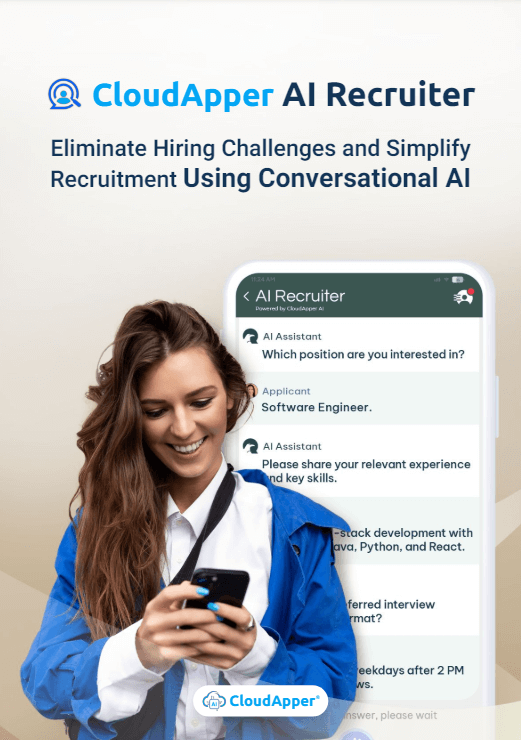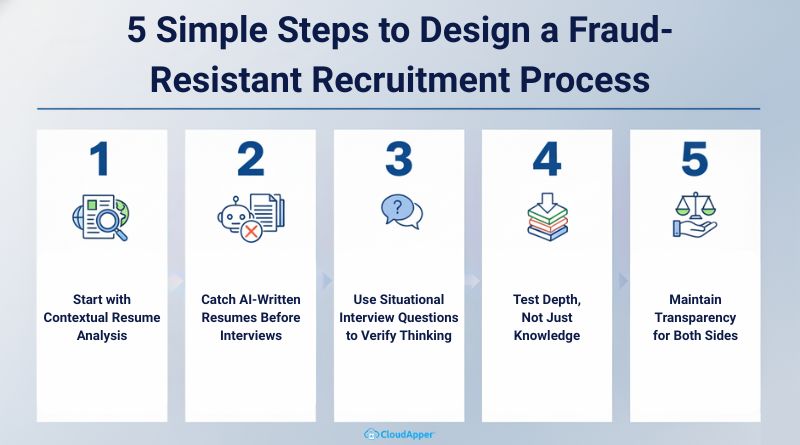Designing a Fraud-Resistant Recruitment Process is no longer optional. With AI and smarter checks, you can detect fake resumes, catch AI-written claims, and verify real experience before interviews begin—protecting time, budget, and hiring confidence.
TL;DR
- A Fraud-Resistant Recruitment Process verifies logic, context, and real experience instead of relying on keywords.
- AI helps detect fake resumes and catch AI-written content using contextual resume analysis.
- Situational interview questions reveal real thinking and help detect live AI interview assistants.
- CloudApper AI Recruiter automates screening, tests reasoning, and flags inconsistencies across resumes and responses.
- This method protects recruiters’ time and helps genuine candidates stand out more clearly.
Table of Contents
Here’s what I see happening regularly these days: candidates are using AI to generate perfect resumes. They’re deepfaking their way through video calls. Some are even using live AI interview assistants during calls, feeding them answers in real time. The damage isn’t just about wasting your time. I’ve seen companies lose tens of thousands of dollars because they hired someone who wasn’t who they claimed to be. Building a fraud-resistant recruitment process isn’t optional anymore. It’s essential.

For more information on CloudApper AI Recruiter visit our page here.
The good news is AI gives you the edge you need to stay ahead of fraudsters who are also using AI. Tools like CloudApper AI Recruiter are already helping companies catch fraud before it becomes a nightmare. But you need a complete system, not just a single tool. Let me walk you through exactly how to design a fraud-resistant recruitment process that actually works.
Why Recruitment Fraud Is Rising
Fraud in hiring is rarely about lies. It often begins with exaggeration. Candidates use tools to rewrite ordinary experience into impressive achievements. They copy answers, reuse descriptions, and sometimes rely on live AI interview assistants to handle real-time responses during calls.
Here’s why this matters for you:
- You waste hours interviewing candidates who don’t actually match their resumes.
- You end up with bad hires who can’t perform well and are unable to fit into your company culture
- Good candidates lose opportunities because others use shortcuts.
This is why many teams now focus on designing a fraud-resistant recruitment process that protects every stage — from screening to final interviews.
5 Simple Steps to Design a Fraud-Resistant Recruitment Process
Building a fraud-resistant recruitment process doesn’t mean adding new steps to it. It means to verify claims smartly. Instead of checking only keywords, it checks logic, context, and consistency. Instead of memorised job duties, it asks for real-life examples. Instead of generic interviews, it uses real-life scenario-based questions that test decision-making.
From what I’ve seen in real recruitment environments, five elements are essential:
| Key Area | Why It Matters |
| Resume authenticity | Prevents resume fraud before interviews |
| Context relevance | Test experience against real scenarios |
| Candidate reasoning | Evaluates logic, not memorised lines |
| Identity clarity | Flag candidates who use help from others |
| Ongoing engagement | Prevents ghosting and drop-off |
Let’s break these down so you can apply them to your own workflows.
Step 1: Start with Contextual Resume Analysis
A polished resume doesn’t always mean real experience. To detect a fake resume, you need contextual resume analysis, which means asking: Does this experience make sense for the role? For example, if someone claims leadership experience with just one year in the field, that’s a signal to review closely.
Here’s what to look for:
- Do job titles match expected career growth?
- Are responsibilities realistic for the stated role?
- Are metrics specific or too generic?
- Would someone at that level handle those tasks?
CloudApper AI Recruiter automates this part by screening resumes and generating follow-up questions automatically. It catches inconsistencies early and helps you build an anti-fraud recruitment process before interviews even begin.
Step 2: Catch AI-Written Resumes Before Interviews
Many resumes now look similar because AI tools rewrite them using templates. You can often catch AI-written resumes through:
- Repetitive tone
- Unusual grammar consistency
- Perfect formatting across every section
- Copy-paste style job summaries
CloudApper AI Recruiter analyzes resume patterns and flags content that likely comes from AI. It doesn’t reject the candidate. It simply alerts recruiters to review more carefully.
This step protects your recruitment process from the influence of polished but unsupported claims.
Step 3: Use Situational Interview Questions to Verify Thinking
To detect live AI interview assistants, you need questions that AI tools struggle to answer. This is where situational interview questions are essential. Instead of asking “What were your responsibilities?” try this:
“What was the hardest decision you made in that role, and who helped you make it?”
When answers are short, vague, or overly structured, you get a better sense of whether the candidate actually lived the experience or copied it. These questions make your hiring process stronger without making interviews longer.
Here are three more examples you can try:
| Resume Claim | Situational Question |
| “I led client escalations.” | “Tell me about a client escalation you handled. What triggered it and how was it resolved?” |
| “Managed a team.” | “How did you earn the team’s trust when you joined?” |
| “Improved processes” | “What was the process before your update, and what changed after?” |
These questions reveal real thinking. They reduce resume fraud and make candidate screening sharper.
Don’t let polished resumes fool your hiring team. Let AI test real thinking before the call starts.
Step 4: Test Depth, Not Just Knowledge
Many candidates can memorise answers but struggle with follow-ups. That’s where your fraud-resistant recruitment process becomes powerful.
Ask questions like:
- “What would you do differently if you had more time?”
- “Which tool helped you most in that project?”
- “How did you measure success?”
These require real experiences. AI tools and memorised scripts often fail here. CloudApper AI Recruiter also uses this method during automated pre-screening, helping teams detect gaps before interviews begin.
Step 5: Maintain Transparency for Both Sides
A fraud-resistant recruitment process doesn’t have to be hostile. Candidates appreciate transparency when expectations are clear. Let candidates know:
- Situational questions will be used
- Job experience may be validated
- Screening focuses on reasoning, not pressure
This builds trust. Genuine candidates perform better. Candidates using shortcuts often reconsider applying.
Why This Method Works in Real Hiring
I’ve seen recruiters move from frustration to control after applying these steps. They waste less time on weak candidates. They interview fewer people but make better decisions. Hiring managers trust the process more. And most importantly, candidates who genuinely fit the role start to stand out naturally.
A strong fraud-resistant recruitment process doesn’t punish candidates. It protects good talent from being overshadowed by polished but shallow applications.
How CloudApper AI Recruiter Makes It Easier
Here’s how recruiters use CloudApper AI Recruiter to build a fraud-resistant recruitment process smoothly:
- Scans resumes to catch AI-written resume structures
- Uses contextual resume analysis to test claims
- Generates situational interview questions automatically
- Helps detect live AI interview assistants through logic tests
- Scores every resume for clarity, depth, and consistency
- Integrates with your ATS without changing workflows
Instead of making hiring strict, it makes it clear. And when clarity enters the process, real talent naturally rises to the top.
Final Thoughts
Fraud in recruitment is changing fast, but your process can stay ahead. You don’t need tougher filters. You need better signals. When you combine contextual resume analysis, situational interview questions, and AI-powered consistency checks, you build a real fraud-resistant recruitment process that protects both candidates and hiring teams.
Ready to build a Fraud-Resistant Recruitment Process that actually works?

Reduce Time-to-Hire by 97% with AI for Talent Acquisition
Recruit skilled, culturally fit, and diverse candidates with CloudApper’s state-of-the-art AI resume screening, automated interview scheduling, and offer letter generation.
Learn more | Download BrochureFrequently Asked Questions
-
What is a Fraud-Resistant Recruitment Process?
It’s a hiring approach that verifies candidate claims through logic, context, and consistency instead of relying only on keywords or manual resume checks. -
How can AI help detect a fake resume?
AI tools analyze language patterns, compare experience with role standards, and use contextual resume analysis to find inconsistencies that signal resume fraud. -
What interview method helps catch AI-written or copied answers?
Situational interview questions are highly effective. They test reasoning and real-life experience, making it difficult for candidates to rely on memorized or AI-generated responses. -
How does CloudApper AI Recruiter support a Fraud-Resistant Recruitment Process?
It screens resumes, tests logic, generates situational interview questions, and helps detect live AI interview assistants during pre-screening and interviews. -
Can this method improve hiring quality without increasing workload?
Yes. AI tools automate verification and candidate screening, saving time while helping recruiters focus only on candidates with real and relevant experience.
What is CloudApper AI Platform?
CloudApper AI is an advanced platform that enables organizations to integrate AI into their existing enterprise systems effortlessly, without the need for technical expertise, costly development, or upgrading the underlying infrastructure. By transforming legacy systems into AI-capable solutions, CloudApper allows companies to harness the power of Generative AI quickly and efficiently. This approach has been successfully implemented with leading systems like UKG, Workday, Oracle, Paradox, Amazon AWS Bedrock and can be applied across various industries, helping businesses enhance productivity, automate processes, and gain deeper insights without the usual complexities. With CloudApper AI, you can start experiencing the transformative benefits of AI today. Learn More

CloudApper AI Solutions for HR



- Works with
- and more.
Similar Posts

How to Use AI in Recruiting: A Complete Guide for…

10 Essential Registered Nurse (RN) Interview Questions to Ask (And…

















